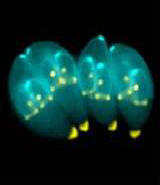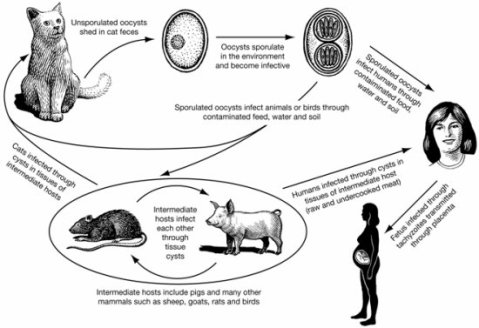Life Cycle and Species Interactions
This is a life cycle schematic obtained from The Queen's Printer's of Ontario. They sent me this really cool license!
The Life cycle of Toxoplasma begins as an unsporulated oocyst, which is a non-infective egg cell. These cells sporulate and make sporozoites in the environment to become infective. These are found in the feces of infected cats (6).
Water, surrounding soil, and food can become contaminated with
these infective cells. When these are ingested by a mouse, or
another intermediate host, the sporozoites invade almost every kind
of tissue in the host's body.
 They then begin to multiply asexually
by endodyogeny. At this point the sporozoites are called
tachyzoites. They multiply very quickly forming pseudocysts inside
host cells, which burst open to release more tachyzoites. After
the first few days of infection, the tachyzoites are called
bradyzoites. They multiply more slowly and stop bursting out of
pseudocysts. They form shelled cysts to hide in the host's tissues
until the second and final host, the cat, eats the intermediate
host (6,9).
They then begin to multiply asexually
by endodyogeny. At this point the sporozoites are called
tachyzoites. They multiply very quickly forming pseudocysts inside
host cells, which burst open to release more tachyzoites. After
the first few days of infection, the tachyzoites are called
bradyzoites. They multiply more slowly and stop bursting out of
pseudocysts. They form shelled cysts to hide in the host's tissues
until the second and final host, the cat, eats the intermediate
host (6,9).
Inside the cat, the cysts go through gametogony formation of zygotes, then oocysts, then sporonts, then sporoblasts, and finally sporozoites to complete the sexual life cycle (6,7).
T. gondii also infects humans as an intermediate host, causing Toxoplasmosis. This can happen if a human ingests undercooked or contaminated meat. A human can also be infected by coming in close contact with the contents of cat litter boxes, which is one reason the percentage of infection among humans is so high. Once inside a human, T. gondii undergoes the same rapid multiplication in which flu like symptoms might be had, then settles into cyst formation and hiding, however it is unlikely that the human will ever be eaten by the secondary host, the cat. Macrophages are effective in providing immunity against T. gondii (7).
If women are infected after pregnancy there is a chance that their infants will be infected as well. This can lead to birth defects or early abortion (1).
Top | Host Environment | Home | Adaptation

